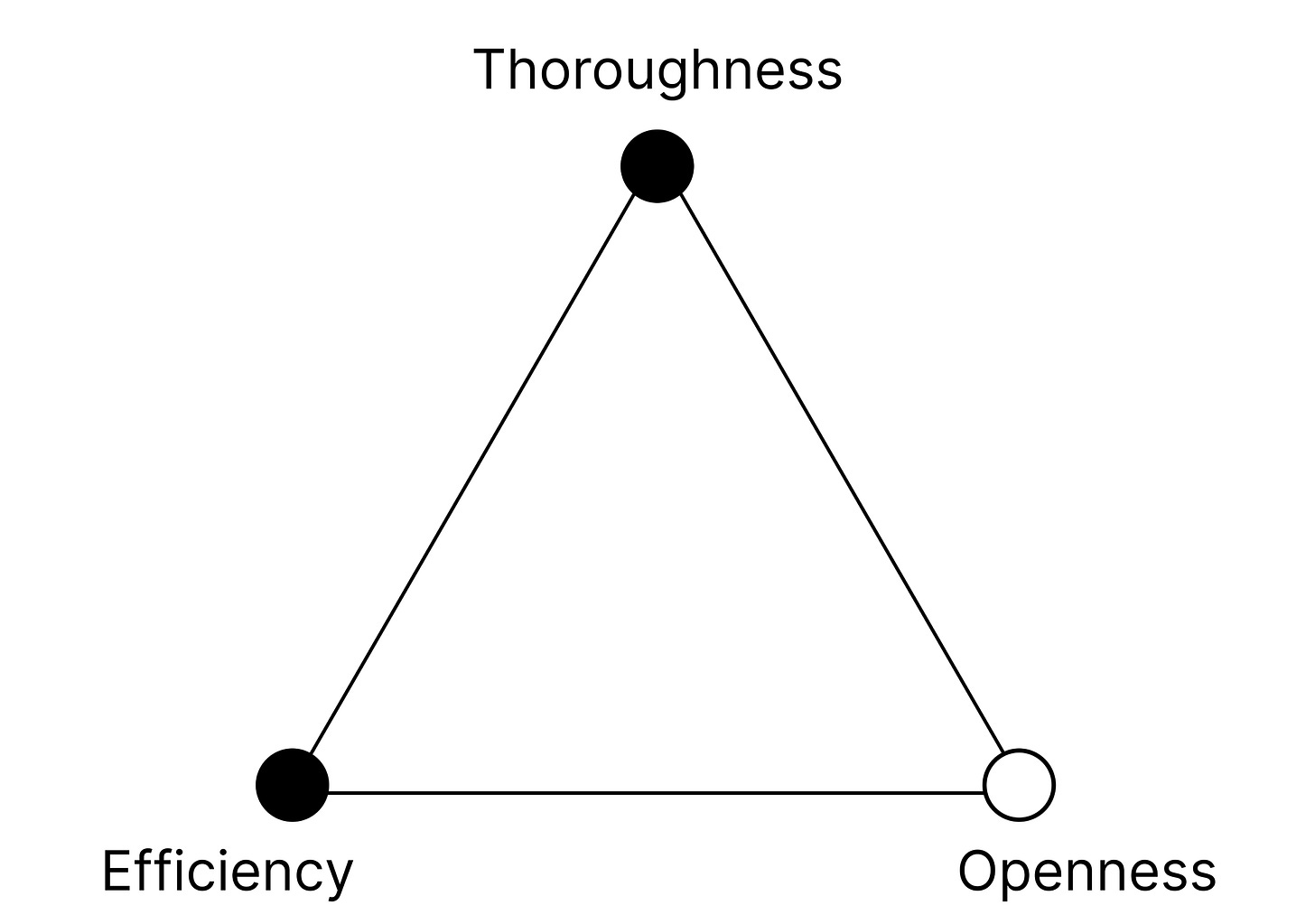Welcome back to The Engine Room – an optional, supplementary section for Blundercheck subscribers, comprising AI-assisted briefs related to safety, work, tactics, and analysis. Like stockfish, for readers.
Writing Methodology: GPT-5 [Thinking, Search] + Hand Edits - Prompt: "You're an analyst expected to prepare a brief on the Efficiency Thoroughness Trade Off. Should be no longer than 1000 words. Include a definition, several examples, and a history of the concept."Definition
The ETTO principle says people and organizations constantly trade off efficiency (time, cost, throughput) against thoroughness (safety, quality, reliability). You can increase one only by spending some of the other; you can’t maximize both at once, though you must maintain a minimum of each to succeed. Erik Hollnagel introduced ETTO in his 2009 book and later writing, where he also popularized “ETTOing” to describe the ongoing balancing act in real work.
“The ETTO principle refers to the fact that people (and organisations) as part of their activities frequently – or always – have to make a trade-off between the resources (primarily time and effort) they spend on preparing to do something and the resources (primarily time and effort) they spend on doing it. The trade-off may favour thoroughness over efficiency if safety and quality are the dominant concerns, and efficiency over thoroughness if throughput and output are the dominant concerns. It follows from the ETTO principle that it is never possible to maximise efficiency and thoroughness at the same time. Nor can an activity expect to succeed, if there is not a minimum of either.” - Erik Hollnagel

Why it matters
Most organizations live on tight schedules and budgets while operating in complex, variable conditions. ETTO explains why everyday work must adapt: when productivity pressures rise, thoroughness erodes unless counter-measures restore it; when quality demands spike, efficiency drops unless processes are re-engineered. ETTO underpins modern Safety-II and resilience engineering: safety isn’t just the absence of accidents (Safety-I) but the ability to keep succeeding under changing conditions—which requires deliberate ETTO choices.
Examples
Aviation turnarounds. Ground crews face a clock: pushback on time (efficiency) vs. extra checks for a suspected snag (thoroughness). Airlines use checklists, hold-points, and MEL rules to consciously swing the balance depending on risk.
Emergency departments. Triage nurses decide between moving patients quickly to beds (efficiency) and running fuller assessments (thoroughness). Surge protocols, fast-track lanes, and escalation criteria formalize the trade-off.
Software delivery. Shipping the hotfix today (efficiency) vs. expanding test coverage and code review (thoroughness). Teams adopt feature flags, canary releases, and rollback runbooks to buy speed without abandoning quality.
Manufacturing. Raising line speed (efficiency) can cut inspection depth (thoroughness). Solutions include automated vision checks, sample frequencies, and stop-the-line authority.
Incident response. During an outage, acting immediately with partial information (efficiency) competes with gathering full context (thoroughness). Pre-approved playbooks, SLO-based paging, and “fix-forward vs. roll back” criteria guide the ETTO.
R&D/product discovery. Rapid experiments (efficiency) vs. robust validation and compliance (thoroughness). Organizations protect time for pre-mortems, ethics reviews, and longer-cycle tests when stakes are high.
Pattern to notice: high-stakes contexts shift the slider toward thoroughness; high-optionality or reversible contexts allow greater efficiency, provided escape hatches (rollbacks, isolations) exist.
History & scholarly context
2009 – Formulation. Hollnagel’s The ETTO Principle: Why Things That Go Right Sometimes Go Wrong set out the core claim: successful performance depends on adjustable trade-offs; accidents and surprises often trace back to ETTO choices that usually work—until they don’t.
2010s – ETTOing & Safety-II. Subsequent papers and talks generalized ETTO as “ETTOing,” emphasizing continuous adjustment under resource constraints. In parallel, Safety-II reframed safety as sustaining what goes right, aligning with ETTO’s focus on real-world adaptation.
Applications – ongoing. ETTO informs accident analysis, system dynamics models of organizational drift, and practical guidance in aviation, healthcare, and other high-reliability sectors.
Common misreads
“ETTO means choose efficiency or quality.” No—ETTO argues for explicit, context-sensitive balancing, not a permanent bias to one side.
“ETTO blames frontline shortcuts.” Not inherently. ETTO is just as much, if not moreso, about the context that selects for certain tendencies either towards E or T—targets, staffing, tool design, incentives, and ambient time pressure co-create the trade-off.
“Safety-II ignores accidents.” Safety-II (trying to maximize the # of successful operations) complements Safety-I (traditional conception of safety - trying to minimize the # of things that go wrong); it studies routine success to understand and support the adaptations that keep things safe.
Extension
extended this principle with a third characteristic: openness. This has some interesting implications for traditional ETTOing, adding the challenge of balancing exploration or openness to new methods.Related Blundercheck Posts
No Solutions – Trade-Offs and the goal zero problem.
The Voyage of Theseus – Requisite activity and lowercase aspirations.
One Tension to Rule Them All – Going beyond trade-offs to the idea of tensions.
Core sources: Hollnagel’s book and summary pages remain the canonical references; see the author’s overview and book listing for definitions, examples, and Safety-II ties.



